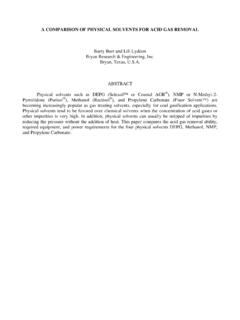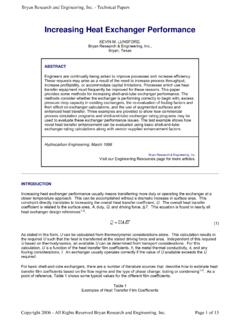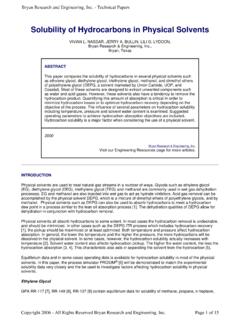Transcription of Sour Water: Where it comes from and how to handle it
1 Sour Water: Where it comes from and how to handle it Luke Addington, Carl Fitz, Kevin Lunsford, and Lili Lyddon, Bryan Research and Engineering, Inc. Dr. Ing. Mariana Siwek, Verfahrenstechnik und Automatisierung GmbH ABSTRACT Sour water strippers are common in gas processing facilities, sulfur recovery units, wellhead facilities, and refinery applications. Understanding the variables allows engineers to better optimize the initial design and operation. This paper reviews options for sour water stripper configuration and presents a method to optimize stripper operation by finding the most efficient operating parameters.
2 Options investigated include: single or double column for increased product purity; addition of acid or caustic for improved performance; refluxed or non-refluxed columns to mitigate water in the overhead gases; condenser or pump-around and their effects on overhead composition; reboiler, direct steam injection, or a combination of these and the effect they have on corrosion concerns. In addition, optimization of the steam rate is investigated. Overall stage efficiency for trayed strippers, HETP for packed strippers and individual component efficiencies are discussed based on available sour water stripper operating data.
3 2 Sour Water: From Where it comes and how it is handled Section 1: Sources of Sour Water Gas Processing Water is the single largest waste stream in oil and gas production worldwide. Wastewater streams come from a variety of sources, the largest of which is associated or production water. Other sources of wastewater include water used during startup and industrial hygiene, purge water from amine sweetening units (ASU), and wash water used in the tail gas treating section (TGTU) of the sulfur recovery unit (SRU).
4 Of these sources, associated water is the largest in total volume; however, the latter two are the largest sources of sour water. Water always exists in oil and gas reservoirs, often sitting towards the bottom of the production zone. While production may be relatively dry at the beginning of a field s life, water-to-hydrocarbon ratios will increase over the life of a well as hydrocarbons are depleted and water begins migrating upwards to areas of production. The United States averages around ten barrels of associated water per barrel of oil produced [1].
5 There are a variety of impurities found in this associated water, such as oil and grease, suspended solids, BTEX/VOCs, as well as sulfur and ammonia. Table 1 lists the concentration of typical contaminants in associated water from sources in the Gulf of Mexico [2] and in Pennsylvania [3]. Notice that the largest concentration of contaminants is the suspended solids while the smallest is typically sulfur species and ammonia, those components typically removed in a sour water stripper.
6 Table 1 : Typical associated water contaminant concentrations Gulf of Mexico (mg/L) [2] Venango County, Pennsylvania (mg/L) [3] Oil and Grease Suspended Solids 141 20-614 BTEX/VOCs 20 1-1,000 Sulfur 42 1-584 Ammonia As a waste stream, associated water is disposed of in a variety of ways, depending on the production site s geographical location, geological concerns, the types of contaminants in the water, and whether production is onshore or offshore. The overwhelming majority of associated water is reinjected into either the production reservoir for Enhanced Oil Recovery (EOR) or into depleted or unused underground reservoirs.
7 As much as 95% of onshore associated water is disposed of in this way [4]. The implication is that although associated water is a huge waste, much of it is minimally treated and readily disposed of back into reservoir rock. The remaining uninjected associated water is either used beneficially or disposed of on the surface in evaporation ponds. Beneficial uses include agricultural use when circumstances allow, such as US 3 onshore reservoirs that produce water with a low salt content and lie west of the 98th meridian [5].
8 Some water is also treated and reused in gas processing facilities [6]. Evaporation ponds, as a means of onshore disposal, are falling out of favor due to the additional processing needed and environmental concerns such as salt contamination of surface soil and erosion [7]. Table 2 provides a summary of US onshore associated water disposal practices. Table 2 : Summary of Disposal Practices for Onshore Produced Water [4] Method Percent of Onshore Produced Water Injected for Enhanced Recovery 57% Injected for Disposal 36% Beneficial Use 4% Evaporations 2% Treat and Discharge 1% Others <1% Offshore water disposal practices for associated water vary from onshore practices.
9 Drilling injection wells and setting up the infrastructure to get the produced water from the platform back to the injection site can be cost prohibitive, so associated water is not typically reinjected offshore [4]. Some production water is treated and reused; however, the majority is simply treated and discharged into the sea [1]. The primary contaminants of concern for this discharged water are suspended solids, oil, and BTEX/VOCs. Removal of these contaminants, by means of coalescers or degassing units, often results in the by-removal of any sour components.
10 This wastewater, therefore, does not need to be introduced to a sour water stripper. The net result is that the primary source of sour water being sent to sour water strippers in upstream applications is not comprised of associated water. In rare cases, amine sweetening units in upstream applications may be sources of sour water. In most cases, the sweet gas temperature is higher than the inlet gas temperature due to absorption of acid gas components in the absorber. The increase in gas temperature results in water actually being removed from the amine solution.






